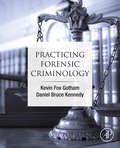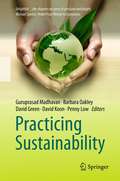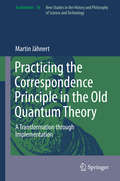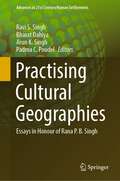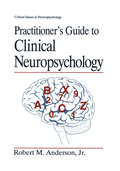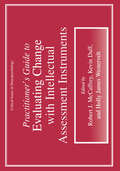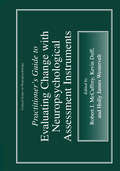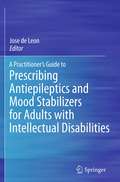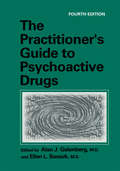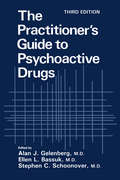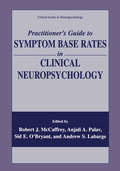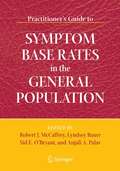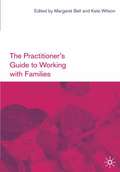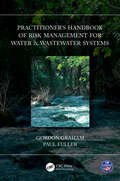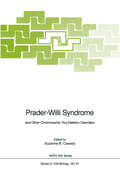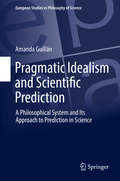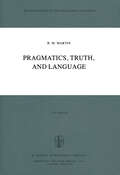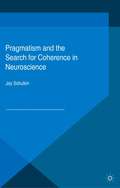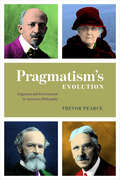- Table View
- List View
Practicing Forensic Criminology
by Kevin Fox Gotham Daniel Bruce KennedyPracticing Forensic Criminology draws on examples from actual court cases and expert witness reports and testimony to demonstrate the merits and uses of substantive criminological knowledge in the applied setting of civil law and the courts. Throughout the book, the authors provide a highly readable, informative discussion of how forensic criminologists can apply their research and teaching skills to assist judges and juries in rendering legal decisions. Engaging and lively, the chapters include excerpts from forensic criminological investigations, in-depth discussions of the methodological and analytical bases of these investigations, and important lessons learned from real litigation cases. Case examples are drawn from the forensic realms of premises liability, administrative negligence, workplace violence, wrongful conviction litigation, and litigation involving police departments and corrections facilities. Well referenced and thoroughly researched, Practicing Forensic Criminology serves as an introduction to the vast and heterogeneous field of forensic social science that is rapidly changing and expanding. This unique and original book guides readers through the research work of expert witnesses working as consultants, researchers, and crime analysts and investigators. Offering expert criminological insights into litigation cases, the chapters reveal how forensic social science research can be an effective mechanism for reaching beyond the academy to influence public policy reform and legal proceedings. Practicing Forensic Criminology will appeal to a diverse audience, including social scientists, criminal justice students and researchers, expert witnesses, attorneys, judges, and students of judicial proceedings seeking to understand the value and impact of criminology in the civil court system. Introduces readers to the impact of evidence-based criminological theory and forensic social science investigations in the legal systemDemonstrates the usefulness of forensic criminology as a research tool, revealing novel relational dynamics among crime events and the larger socio-spatial contextAdvances the development of a "translational criminology" – i.e., the translation of knowledge from criminological theory and research to forensic practice – as an expedient to forming robust interactive relationships among criminological social scientists and policy makers
Practicing Sustainability
by Guruprasad Madhavan, Barbara Oakley, David Green, David Koon and Penny LowSustainability applies to everybody. But everybody applies it differently, by defining and shaping it differently—much as water is edged and shaped by its container. It is conceived in absolute terms but underpinned by a great diversity of relatively “green”—and sometimes contradictory—practices that can each make society only more or less sustainable. In Practicing Sustainability, chefs, poets, music directors, evangelical pastors, skyscraper architects, artists, filmmakers, as well as scientific leaders, entrepreneurs, educators, business executives, policy makers, and the contrarians, shed light on our understanding of sustainability and the role that each of us can play. Each contributor addresses what sustainability means, what is most appealing about the concept, and what they would like to change to improve the perception and practice of sustainability. What emerges from their essays is a wide spectrum of views that confirm an important insight: Sustainability is pursued in different ways not only due to different interpretations, but also because of varying incentives, trade-offs, and altruistic motives. Practicing and achieving sustainability starts with a willingness to look critically at the concept. It also means enabling rich and vigorous discussion based on pragmatism and common sense to determine a framework for best ideas and practices. With time and the much needed critical thinking, sustainable development will become a more integral part of our culture. By sharing experiences and crisp insights from today’s savants, Practicing Sustainability serves as a stepping stone to the future.
Practicing the Correspondence Principle in the Old Quantum Theory: A Transformation through Implementation (Archimedes #56)
by Martin JähnertThis book presents a history of the correspondence principle from a new perspective. The author provides a unique exploration of the relation between the practice of theory and conceptual development in physics. In the process, he argues for a new understanding of the history of the old quantum theory and the emergence of quantum mechanics.The analysis looks at how the correspondence principle was disseminated and how the principle was applied as a research tool during the 1920s. It provides new insights into the interaction between theoretical tools and scientific problems and shows that the use of this theoretical tool changed the tool itself in a process of transformation through implementation. This process, the author claims, was responsible for the conceptual development of the correspondence principle. This monograph connects to the vast literature in the history of science, which analyzed theoretical practices as based on tacit knowledge, skills, and calculation techniques. It contributes to the historical understanding of quantum physics and the emergence of quantum mechanics. Studying how physicists used a set of tools to solve problems, the author spells out the ‟skillful guessing” that went into the making of quantum theoretical arguments and argues that the integration and implementation of technical resources was a central driving force for the conceptual and theoretical transformation in the old quantum theory.
Practising Cultural Geographies: Essays in Honour of Rana P. B. Singh (Advances in 21st Century Human Settlements)
by Ravi S. Singh Bharat Dahiya Arun K. Singh Padma C. PoudelThis festschrift honours Prof. Rana P.B. Singh who has dedicated his life to teaching and conducting research on cultural geography with a ‘dweller Indian perspective’. The book focuses on the cultural geographies of India, and to an extent that of South Asia. It is a rich collection of 23 essays on the themes apprised by him, covering landscapes, religion, heritage, pilgrimage and tourism, and human settlements.
Practitioner’s Guide to Clinical Neuropsychology (Critical Issues in Neuropsychology)
by Robert M. Anderson Jr.Practitioner’s Guide to Evaluating Change with Intellectual Assessment Instruments (Critical Issues in Neuropsychology)
by Kevin DuffWhile conducting research on intellectual and neuropsychological perfonnance of various patient populations across time, we became aware of the lack of information concerning practice effects associated with many widely used assessment instruments. Although test-retest data were available for almost all of these instruments, it typically came in the form of correlation coefficients and mean changes in performance between assessments was often absent. In a 1995 article (McCaffrey & Westervelt, 1995), we discussed a number of issues relevant to serial neuropsychological and intellectual assessment and concluded that clinical neuropsychological practitioners had few guidelines to assist them in interpreting change in a patient's performance across assessments. This volume represents our efforts at reviewing the literature between 1970 and 1998 and extracting the reported information on practice effects. The tables include the assessment instrument used, information on the subject/patient groups, the sample size fu}, gender, age, intervention, interval between the assessments, scores at both assessment points, and the citation. The tables reflect the existing published literature within intellectual assessment and, therefore, some instruments (e.g., Wechsler tests) comprise a majority of the tables whereas others (e.g., Raven's Progressive Matrices, Stanford-Binet) do not. The test index is arranged by the name of the test as reported in the specific article. We caution readers to refer to the original articles if additional or more specific information is needed.
Practitioner’s Guide to Evaluating Change with Neuropsychological Assessment Instruments (Critical Issues in Neuropsychology)
by Robert J. McCaffrey Kevin Duff Holly James WesterveltThe impetus for this volume began with our research in the 1980's involving serial neuropsychological evaluation with various patient populations. At that time, reports on the practice effects associated with routinely utilized clinical neuropsychological instruments were sparse. While test-retest data were available for almost all assessment instruments, this was usually in the form of correlation coefficients and not changes in mean performance between or across assessment periods (see McCaffrey & Westervelt, 1995 for a detailed discussion of these and related issues). Clinical neuropsychological practitioners had few guidelines to assist them in determining if a change in a patient's performance across assessments was due to an intervention, maturation, practice effects, or a combination of factors. This volume represents our efforts at reviewing the literature between 1970 and 1998 and extracting the reported information on practice effects. The tables include the assessment instrument used, information on the subject/patient groups, the sample size (n}, gender, age, intervention, interval between the assessments, scores at both assessment points, and the citation. Those studies that reported data on more than two assessment points are indicated by a notation~ however, any data beyond the second assessment are not reported and the interested reader should refer to the original article. The tables are arranged alphabetically for the most widely used assessment instruments. Those instruments for which there was limited data on practice effects are grouped by "domain" (e. g.
A Practitioner's Guide to Prescribing Antiepileptics and Mood Stabilizers for Adults with Intellectual Disabilities
by Jose LeonEmotional, behavioral, and neuropsychiatric conditions are common in individuals with intellectual disabilities (IDs), most notably epilepsy, aggression, self-injurious behaviors, and bipolar and other mood disorders. Despite the prevalence of such problems, there is a scarcity in the literature of reliable information on medical treatments for those with IDs.A Practitioner's Guide to Prescribing Antiepileptics and Mood Stabilizers for Adults with Intellectual Disabilities provides a detailed framework for prescribing for this challenging population. Featuring the most up-to-date information on factors that inform prescribing, the Guide addresses basic issues and controversies (e.g., the rift between evidence-based and personalized medicine) in treating adults with cognitive deficits. Clients' specific needs are emphasized in developing appropriate and effective pharmacological intervention for improved outcomes and quality of life. Drugs discussed in the Guide include carbamazepine, clonazepam, diazepam, ethosuximide, felbamate, gabapentin, lacosamide, lamotrigine, levetiracetam, lithium, lorazepam, oxcarbazepine, phenobarbital, phenytoin, pregabalin, primidone, rufinamide, tiagabine, topiramate, valproate, and zonisamide. For each of these compounds, the guidelines cover:Indications for use; relative and absolute contraindications.Assessment during treatment; therapeutic drug monitoring; warning signs and symptoms for caretakers.Dosage: administration; initial and maximum recommended dosage; modifications associated with drug-drug interactions, personal characteristics, and (where appropriate) genetic variations.Adverse drug reactions: common, relatively uncommon, and potentially lethal, plus risk of metabolic syndrome.Guidelines for discontinuation.References, tables, and drug utilization reviews.A Practitioner's Guide to Prescribing Antiepileptics and Mood Stabilizers for Adults with Intellectual Disabilities is an indispensable decision-making reference for psychiatrists, neuropsychologists, psychopharmacologists, neurologists, internists, and clinical psychologists.
The Practitioner’s Guide to Psychoactive Drugs (Topics In General Psychiatry Ser.)
by Alan J. Gelenberg Ellen L. BassukOnce again, in their new edition of a classic American handbook of clinical psycho pharmacology, Drs. Gelenberg and Bassuk and their colleagues have produced a master work of sound clinical guidelines for the use of medicines as an increasingly central component of contemporary psychiatric practice. They have recruited an outstanding panel of coauthors, but have managed to maintain a high level of consistency of quality and style throughout the many chapters on specific classes of psychiatric illnesses and their corresponding treatments. The book continues to encapsulate the clinically rele vant essentials of the pharmacology of each major class of psychotropic agents in a way that clinicians can easily grasp. Moreover, it provides sound and carefully consid ered specific guidelines to diagnosis, drug selection, and dosing and patient assessment, with particularly rich presentations on the recognition and management of adverse effects. Inclusion of chapters on pediatric and geriatric populations and on topics pertaining to substance abuse disorders and medicolegal aspects of the field are unusual in books of this kind, and so are particularly valuable. Students and trainees will appreciate the handbook's well-organized and readable style, and practicing clinicans should be satisified with its balanced consideration of older, standard treatments as well as the latest medicines and trends in clinical psychopharmacology, with glimpses into future developments.
The Practitioner’s Guide to Psychoactive Drugs
by Alan J. Gelenberg Ellen L. Bassuk Stephen C. SchoonoverIn the eight years since the publication of the second edition of this Guide, psycho phannacotherapy has made many advances not only through the discovery of new medications but by the effective directing of their use to an ever-increasing variety of clinical disorders. These welcome developments are reflected in the concurrent growth and development of the Guide itself, which now enters adulthood with renewed vigor. Under the thoughtful and scholarly leadership of Dr. Alan Gelenberg, the third edition has undergone a significant transformation designed to meet the needs of the modem clinician. The panel of contributors is nearly double that of the former edition with the addition of nine new authors, who have helped in the major revision and rewriting of the text and in a broadening of the topics included. As a conse quence, the reader is assured of a thorough and thoroughly up-to-date coverage of current psychopharmacology that is both accurate and aimed at clinical utility. Having reached maturity, the third edition, while maintaining the lineaments of its earlier versions, is a considerably expanded and strengthened guide to treatment. Although now more encyclopedic in content, the new Practitioner' s Guide to Psy choactive Drugs retains the virtues of a clinical vade mecum that informed its predecessors and have eamed it a place by the patient's bedside for weIl over a decade. One may confidently anticipate its long and flourishing career in the years ahead. John C. Nemiah, M.D.
Practitioner’s Guide to Symptom Base Rates in Clinical Neuropsychology (Critical Issues in Neuropsychology)
by Robert J. McCaffrey Anjali A. Palav Sid O'Bryant Andrew S. LabargeThis volume serves as an aid in the process of differential diagnosis which frequently confronts neuropsychologists. The guide is a compendium of information of the base rates of symptoms across a variety of disorders which neuropsychologists encounter. In addition to serving as a convenient source of information on symptom base rates, this volume also contains detailed cross referencing of symptoms across disorders. It is intended for use by clinical neuropsychologists and psychologists.
Practitioner's Guide to Symptom Base Rates in the General Population
by Robert J. McCaffrey Lyndsey Bauer Sid O'Bryant Anjali A. PalavPractitioner's Guide To Working With Families
by Margaret Bell Kate WilsonThis book offers a clear and coherent guide to working with families for practitioners and students in social work, health, counselling and related professions. It brings together recent thinking on the historical and contemporary constructions of the family in such a way as to provide a helpful framework for practitioners working in a variety of settings in the field. It offers up-to-date information on political, legislative and theoretical frameworks, and it reviews and illustrates a wide range of approaches and practice skills for working with families with different problems in different contexts.
Practitioner's Guide To Working With Families (PDF)
by Margaret Bell Kate WilsonThis book offers a clear and coherent guide to working with families for practitioners and students in social work, health, counselling and related professions. It brings together recent thinking on the historical and contemporary constructions of the family in such a way as to provide a helpful framework for practitioners working in a variety of settings in the field. It offers up-to-date information on political, legislative and theoretical frameworks, and it reviews and illustrates a wide range of approaches and practice skills for working with families with different problems in different contexts.
Practitioner’s Handbook of Risk Management for Water & Wastewater Systems
by Gordon Graham Paul FullerReal risk management is predicated on the eventuality of human erraticism and therefore necessitates the design of resilient systems, such as control measures, policies, procedures, processes, rules, checklists, and protocols, to protect organizations against unpredictability. However, these systems aren’t enough to prevent tragedies, they must be paired with an organizational culture that drives employee understanding, adherence, questioning, and enforcement of these systems. Success is conditioned on this interdependent relationship, meaning employees do the right thing, the right way every time, as they unequivocally support the underlying rationale of their organizational systems, mission, and purpose. This dynamic, inculcated way of thinking is intrinsic to high-reliability organizations and should be the aspiration of all executives, managers, and supervisors. Authors Gordon Graham and Paul Fuller impart a wide range of practical information on resilient systems- as these thoughtfully designed protocols, kept up-to-date and properly implemented, serve to minimize organizational risk in the water and wastewater industry. Features: Offers guidance for organizations to maximize service, enhance safety, and minimize liability. Presents fundamental background on risk, systems, risk management, as well as factors leading to industrial tragedies and how to avoid or mitigate them. Includes practical examples to demonstrate the necessary steps to transform a water facility into a highly reliable and safe organization. Centering on organizational risk management, Practitioner’s Handbook of Risk Management for Water & Wastewater Systems provides the investigative tools for risk assessments and risk/frequency matrixes to effectively recognize and prioritize the thousands of risks facing professionals working in the water and wastewater industry today.
Practitioner’s Handbook of Risk Management for Water & Wastewater Systems
by Gordon Graham Paul FullerReal risk management is predicated on the eventuality of human erraticism and therefore necessitates the design of resilient systems, such as control measures, policies, procedures, processes, rules, checklists, and protocols, to protect organizations against unpredictability. However, these systems aren’t enough to prevent tragedies, they must be paired with an organizational culture that drives employee understanding, adherence, questioning, and enforcement of these systems. Success is conditioned on this interdependent relationship, meaning employees do the right thing, the right way every time, as they unequivocally support the underlying rationale of their organizational systems, mission, and purpose. This dynamic, inculcated way of thinking is intrinsic to high-reliability organizations and should be the aspiration of all executives, managers, and supervisors. Authors Gordon Graham and Paul Fuller impart a wide range of practical information on resilient systems- as these thoughtfully designed protocols, kept up-to-date and properly implemented, serve to minimize organizational risk in the water and wastewater industry. Features: Offers guidance for organizations to maximize service, enhance safety, and minimize liability. Presents fundamental background on risk, systems, risk management, as well as factors leading to industrial tragedies and how to avoid or mitigate them. Includes practical examples to demonstrate the necessary steps to transform a water facility into a highly reliable and safe organization. Centering on organizational risk management, Practitioner’s Handbook of Risk Management for Water & Wastewater Systems provides the investigative tools for risk assessments and risk/frequency matrixes to effectively recognize and prioritize the thousands of risks facing professionals working in the water and wastewater industry today.
Prader-Willi Syndrome: and Other Chromosome 15q Deletion Disorders (Nato ASI Subseries H: #61)
by Suzanne B. CassidyAlthough Prader-Willi syndrome was first described 35 years ago, it was following detection of an interstitial chromosome 15q deletion in some affected patients ten years ago that it became a major focus of multidisciplinary scientific interest. This interest was compounded by the later determination that some patients with a clinically distinct disorder, Angelman syndrome, apparently also had the same chromosome 15q deletion. Subsequently, molecular genetic studies showed that some cytogenetically normal patients with both disorders have uniparental disomy, maternal in Prader-Willi syndrome and paternal in Angelman syndrome. Genetic imprinting has been implicated in this unusual phenomenon. This Workshop was conceived to bring together clinical and basic scientists from around the world whose research was focused on unraveling this unique genetic situation and further delineating these two fascinating disorders. As this volume demonstrates, it was successful in reaching this goal. Laboratory and clinical scientists from 15 countries in four continents participated, and even more countries were represented among the professional and parent observers of its proceedings. Many participants had previously known each other in print only. As a consequence of the Workshop, conclusions could be drawn on several issues. International collaborative research efforts were established. And acquaintances were developed between people who investigate the genetics of these disorders from differing perspectives, resulting in enrichment of approach to answering the complex questions posed by these fascinating conditions. Plans were initiated for another such scientific workshop a few years hence. This volume includes papers presented from the platform.
The Praeger Handbook of Environmental Health [4 volumes]: [4 volumes]
by Robert H. FriisWritten by internationally acclaimed experts in the United States and abroad, this comprehensive set of environmental health articles serves to clarify our impending challenges as well as opportunities for health and wellness.Written in an accessible style that is appropriate for general readers as well as professionals in the environmental health field, this work provides a comprehensive yet coherent review of the principal environmental challenges that confront our society. This four-volume work taps a multidisciplinary team of experts from across the nation to present emerging information about how our world is being impacted, the effects on health and life, and the steps we are taking—and should take—to correct or avoid the problems. The Praeger Handbook of Environmental Health comprises four volumes: Foundations of the Field; Agents of Disease; Water, Air, and Solid Waste; and Current Issues and Emerging Debates. Within each volume, chapters cover the latest scientific research findings in an objective manner and present practical applications of the information. Topics addressed include air and water contaminants, PCBs, hazardous waste, household cleaning products, dioxin, plastics, radiation, radon, electromagnetic fields, and noise and light pollution, just to name a few. This title stands alone in its comprehensive coverage of environmental health topics.
The Praeger Handbook of Environmental Health [4 volumes]: [4 volumes]
Written by internationally acclaimed experts in the United States and abroad, this comprehensive set of environmental health articles serves to clarify our impending challenges as well as opportunities for health and wellness.Written in an accessible style that is appropriate for general readers as well as professionals in the environmental health field, this work provides a comprehensive yet coherent review of the principal environmental challenges that confront our society. This four-volume work taps a multidisciplinary team of experts from across the nation to present emerging information about how our world is being impacted, the effects on health and life, and the steps we are taking—and should take—to correct or avoid the problems. The Praeger Handbook of Environmental Health comprises four volumes: Foundations of the Field; Agents of Disease; Water, Air, and Solid Waste; and Current Issues and Emerging Debates. Within each volume, chapters cover the latest scientific research findings in an objective manner and present practical applications of the information. Topics addressed include air and water contaminants, PCBs, hazardous waste, household cleaning products, dioxin, plastics, radiation, radon, electromagnetic fields, and noise and light pollution, just to name a few. This title stands alone in its comprehensive coverage of environmental health topics.
Pragmatic Idealism and Scientific Prediction: A Philosophical System and Its Approach to Prediction in Science (European Studies in Philosophy of Science)
by Amanda GuillánThis monograph analyzes Nicholas Rescher’s system of pragmatic idealism. It also looks at his approach to prediction in science. Coverage highlights a prominent contribution to a central topic in the philosophy and methodology of science. The author offers a full characterization of Rescher’s system of philosophy. She presents readers with a comprehensive philosophico-methodological analysis of this important work. Her research takes into account different thematic realms: semantic, logical, epistemological, methodological, ontological, axiological, and ethical. The book features three, thematic-parts: I) General Coordinates, Semantic Features and Logical Components of Scientific Prediction; II) Predictive Knowledge and Predictive Processes in Rescher’s Methodological Pragmatism; and III) From Reality to Values: Ontological Features, Axiological Elements, and Ethical Aspects of Scientific Prediction. This insightful analysis offers a critical reconstruction of Rescher’s philosophy. The system he created is often characterized as pragmatic idealism that is open to some realist elements. He is a prominent representative of contemporary pragmatism who has made a great deal of contributions to the study of this topic. This area is crucial for science and it has been little considered in the philosophy of science.
Pragmatics, Truth, and Language (Boston Studies in the Philosophy and History of Science #38)
by R.M. MartinRichard Martin's thoroughly philosophical as well as thoroughly tech nical investigations deserve continued and appreciative study. His sympathy and good cheer do not obscure his rigorous standard, nor do his contemporary sophistication and intellectual independence obscure his critical congeniality toward classical and medieval philosophers. So he deals with old and new; his papers, in his neat self-descriptions, consist of reminders, criticisms, and constructions. They might also be seen as studies in the understanding of truth, ramifying as widely in mathematics, logic, and epistemology as well as metaphysics, as such understanding has required. For us it is a pleasant occasion to welcome Richard Martin's new Boston Studies, and to note his continuously con collection to the structive and critical interventions at the Boston Colloquium for the of Science. Philosophy Boston University Center for the R. S. COHEN Philosophy and History of Science M. W. WARTOFSKY July 1979 vii TABLE OF CONTENTS EDITORIAL PREFACE vii PREFACE xi ACKNOWLEDGEMENTS xv I. Truth and Its Illicit Surrogates II. Some Reminders concerning Truth, Satisfaction, and Reference 17 III. On Disquotation and Intensionality 30 IV. On Truth, Belief, and Modes of Description 42 V. The Pragmatics of Self-Reference 55 VI. On Suppositio and Denotation 72 VII. Of Time and the Null Individual 82 VIII. Existence and Logical Form 95 IX. Tense, Aspect, and Modality 110 X. Of 'Of' 130 XI. Events and Actions: Brand and Kim 144 XII. Why I Am Not a Montague Grammarian 160 XIII.
Pragmatism and the Search for Coherence in Neuroscience
by Jay SchulkinWe have known for over a thousand years that the brain underlies behavioral expression, but effective scientific study of the brain is only very recent. Two things converge in this book: a great respect for neuroscience and its many variations, and a sense of investigation and inquiry demythologized. Think of it as foraging for coherence.
Pragmatism's Evolution: Organism and Environment in American Philosophy
by Trevor PearceIn Pragmatism’s Evolution, Trevor Pearce demonstrates that the philosophical tradition of pragmatism owes an enormous debt to specific biological debates in the late 1800s, especially those concerning the role of the environment in development and evolution. Many are familiar with John Dewey’s 1909 assertion that evolutionary ideas overturned two thousand years of philosophy—but what exactly happened in the fifty years prior to Dewey’s claim? What form did evolutionary ideas take? When and how were they received by American philosophers? Although the various thinkers associated with pragmatism—from Charles Sanders Peirce to Jane Addams and beyond—were towering figures in American intellectual life, few realize the full extent of their engagement with the life sciences. In his analysis, Pearce focuses on a series of debates in biology from 1860 to 1910—from the instincts of honeybees to the inheritance of acquired characteristics—in which the pragmatists were active participants. If we want to understand the pragmatists and their influence, Pearce argues, we need to understand the relationship between pragmatism and biology.
Pragmatism's Evolution: Organism and Environment in American Philosophy
by Trevor PearceIn Pragmatism’s Evolution, Trevor Pearce demonstrates that the philosophical tradition of pragmatism owes an enormous debt to specific biological debates in the late 1800s, especially those concerning the role of the environment in development and evolution. Many are familiar with John Dewey’s 1909 assertion that evolutionary ideas overturned two thousand years of philosophy—but what exactly happened in the fifty years prior to Dewey’s claim? What form did evolutionary ideas take? When and how were they received by American philosophers? Although the various thinkers associated with pragmatism—from Charles Sanders Peirce to Jane Addams and beyond—were towering figures in American intellectual life, few realize the full extent of their engagement with the life sciences. In his analysis, Pearce focuses on a series of debates in biology from 1860 to 1910—from the instincts of honeybees to the inheritance of acquired characteristics—in which the pragmatists were active participants. If we want to understand the pragmatists and their influence, Pearce argues, we need to understand the relationship between pragmatism and biology.
Pragmatism's Evolution: Organism and Environment in American Philosophy
by Trevor PearceIn Pragmatism’s Evolution, Trevor Pearce demonstrates that the philosophical tradition of pragmatism owes an enormous debt to specific biological debates in the late 1800s, especially those concerning the role of the environment in development and evolution. Many are familiar with John Dewey’s 1909 assertion that evolutionary ideas overturned two thousand years of philosophy—but what exactly happened in the fifty years prior to Dewey’s claim? What form did evolutionary ideas take? When and how were they received by American philosophers? Although the various thinkers associated with pragmatism—from Charles Sanders Peirce to Jane Addams and beyond—were towering figures in American intellectual life, few realize the full extent of their engagement with the life sciences. In his analysis, Pearce focuses on a series of debates in biology from 1860 to 1910—from the instincts of honeybees to the inheritance of acquired characteristics—in which the pragmatists were active participants. If we want to understand the pragmatists and their influence, Pearce argues, we need to understand the relationship between pragmatism and biology.
